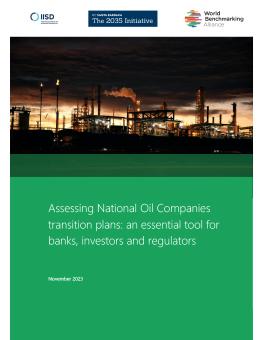
Assessing National Oil Companies' Transition Plans: An essential tool for banks, investors, and regulators
Any chance of limiting global warming to 1.5°C—and even well below 2°C—requires a better understanding of how national oil companies (NOCs) function and what levers can be activated to support their decarbonization. Contrary to what is often perceived, not only governments but also standard setters, investors, and banks can play an important role in NOCs' decarbonization. This brief offers guidance on how such actors can drive NOCs' transition plans to align with the 1.5°C target.
National oil companies (NOCs) account for half of oil and gas production, 40% of investments in the sector, and two thirds of the planet's hydrocarbon reserves. An assessment of 99 leading oil and gas companies, which includes 40 NOCs, shows that NOCs are expected to exceed international oil companies in their carbon budgets. Any chance of limiting global warming to 1.5°C and even well below 2°C therefore requires a better understanding of how NOCs function and what levers can be activated to support their decarbonization.
This brief, developed by the World Benchmarking Alliance, International Institute for Sustainable Development, and University of California Santa Barbara, builds on previous work from its authors, including an assessment of how investors can jumpstart energy transitions for NOCs and how NOCs themselves fare with their decarbonization strategies. It focuses particularly on internationally exposed NOCs (those that are more dependent on debt or equity financing or those that are listed). Contrary to what is often perceived, financial actors, like governments, can have an important impact on NOCs. However, there is still a disconnect between financial actors and the need for NOCs to decarbonize. In particular, NOCs' credit ratings are currently not linked to their low-carbon transition plans. Given the heightened transition risks many NOCs will face in the future, the benefits of requiring such a link should act as a strong incentive for financiers to connect the dots.
The brief has three main objectives:
- First, it offers guidance to investors, banks, standard setters, and governments on how NOCs can enhance their low-carbon transition plans and align their investments with the 1.5°C target under the Paris Agreement.
- Second, it delves deeper into how different financial actors can drive NOCs' transition plans.
- Third, it seeks to build momentum ahead of the United Nations Climate Change Conference (COP 28) to raise the bar and ensure NOCs are held accountable for their investments, production plans, and decarbonization strategies.
Participating experts
You might also be interested in
Carbon Minefields: Oil and gas exploration surging to pre-Covid levels
Oil and gas exploration is booming despite an agreement at last year’s COP 28 climate summit to transition away from fossil fuels.
July Edition | Carbon Minefields Oil and Gas Exploration Monitor
In June 2024, six governments issued 18 oil and gas exploration licences with embodied emissions of 14.7 MtCO2, led by Russia and China.
New Agreement Marks First Step in Addressing Energy Charter Treaty Legacy
This is an important move to prevent legacy arbitration claims under the treaty, but more remains to be done.
The Indonesia Cooking Diaries Study
This study evaluates the feasibility and implications of switching from cooking with LPG to induction stoves in Indonesian households.